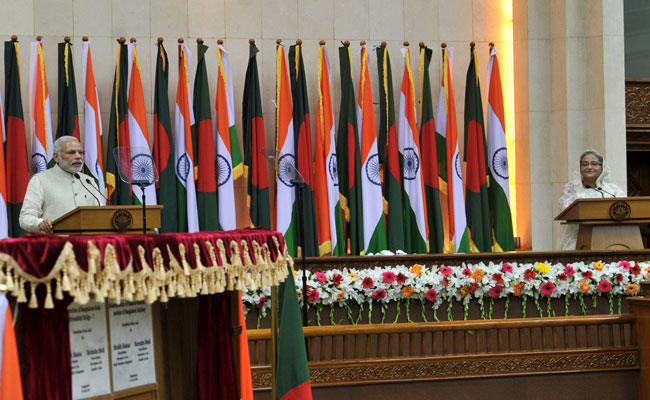
India-Bangladesh: Towards greater economic cooperation
Prof. A.K. Sen Gupta | The Dollar Business
 The Prime Minister, Narendra Modi giving his statement to media at the Joint Press Briefing with the Prime Minister of Bangladesh, Ms. Sheikh Hasina, in Dhaka, Bangladesh on June 06, 2015. (Source: PIB, Government of India)
The Prime Minister, Narendra Modi giving his statement to media at the Joint Press Briefing with the Prime Minister of Bangladesh, Ms. Sheikh Hasina, in Dhaka, Bangladesh on June 06, 2015. (Source: PIB, Government of India) A new Chapter was opened in Indo-Bangladesh relations when the Prime Ministers of both nations met very recently in Dhaka to resolve many of the outstanding issues standing in the way of greater economic cooperation between the Asian neighbours. Although such dialogues between the two nations had been carried on earlier, it was only after the personal visit of Prime Minister Modi, that concrete solutions seem to have emerged. Going by press reports, the visit has been variously described as path- breaking and historic for a variety of reasons.  The centre-piece of the visit has been the ratification of the “Land–Boundary Agreement” – a problem area which had been a major stumbling block towards greater bilateral cooperation in various fields , including economic. It is well known that trade and commerce between the two nations had been primarily carried out by land routes and in the absence of a land boundary agreement (LBA), such activities faced obvious limitations. Although theoretically there were more than a dozen identified land routes, major commercial transactions were conducted at the Benapole–Petrapole land port. On a humanitarian basis, the LBA has instilled a sense of statehood and permanency to a large number of people settled in the border areas. Apart from the LBA, the visit also witnessed the signing of 22 Agreements which are reported to address vital sectors like security co-operation, communication and connectivity issues, infrastructure and trade facilitation measures, to mention a few. Among the major agreements, the one on navigation facilities will have immediate benefits to India. Indian cargo vessels will now be allowed to use Chittagong and Mongla ports in Bangladesh . Earlier Indian vessels had to compulsorily take a long route and offload their cargo in Singapore and thereafter load them in vessels which will carry it to Bangladesh. The savings in terms of time and costs is bound to be substantial for Indian vessels by this one agreement alone. Another significant development is the agreement permitting India to have two specially ‘Designated Economic Zones’ exclusively for Indian companies. The Indian Prime Minister, in turn, had offered several measures to accelerate economic and other modes of cooperation between the two nations. A US$ 2 billion line of credit has been offered to Bangladesh for utilization in sectors like infrastructure, power, health and education oriented projects . Power supply to Bangladesh is to be augmented by India from 500MW to 1100MW . This should improve connectivity .Bus services were also flagged off connecting the North-Eastern states to Kolkatta via Dhaka. This measure would also help Bangladesh to explore proximate markets in India’s North eastern sector as also in adjacent territories of Nepal and Bhutan. The idea behind the creation of exclusive Indian economic zones in Bangladesh is also designed to scale up Indian investments in that country and thereby help to correct certain trade imbalances witnessed in the bilateral trade. Bilateral Trade Bilateral Trade, an important facet of economic activity between nations, has not seen any substantial improvement in respect of these two neighbours over the years. Bangladesh exports to India had consisted mainly of primary commodities, though of late some manufactured articles also feature in the list. It’s imports from India, on the other hand comprise high value items like vehicles and parts, electrical and other machinery, rubber articles & organic chemicals. There is a clear imbalance in favour of India, which needs correction if economic cooperation between the two countries is to be accelerated. The following table shows the flows in Foreign Trade between the two countries
The centre-piece of the visit has been the ratification of the “Land–Boundary Agreement” – a problem area which had been a major stumbling block towards greater bilateral cooperation in various fields , including economic. It is well known that trade and commerce between the two nations had been primarily carried out by land routes and in the absence of a land boundary agreement (LBA), such activities faced obvious limitations. Although theoretically there were more than a dozen identified land routes, major commercial transactions were conducted at the Benapole–Petrapole land port. On a humanitarian basis, the LBA has instilled a sense of statehood and permanency to a large number of people settled in the border areas. Apart from the LBA, the visit also witnessed the signing of 22 Agreements which are reported to address vital sectors like security co-operation, communication and connectivity issues, infrastructure and trade facilitation measures, to mention a few. Among the major agreements, the one on navigation facilities will have immediate benefits to India. Indian cargo vessels will now be allowed to use Chittagong and Mongla ports in Bangladesh . Earlier Indian vessels had to compulsorily take a long route and offload their cargo in Singapore and thereafter load them in vessels which will carry it to Bangladesh. The savings in terms of time and costs is bound to be substantial for Indian vessels by this one agreement alone. Another significant development is the agreement permitting India to have two specially ‘Designated Economic Zones’ exclusively for Indian companies. The Indian Prime Minister, in turn, had offered several measures to accelerate economic and other modes of cooperation between the two nations. A US$ 2 billion line of credit has been offered to Bangladesh for utilization in sectors like infrastructure, power, health and education oriented projects . Power supply to Bangladesh is to be augmented by India from 500MW to 1100MW . This should improve connectivity .Bus services were also flagged off connecting the North-Eastern states to Kolkatta via Dhaka. This measure would also help Bangladesh to explore proximate markets in India’s North eastern sector as also in adjacent territories of Nepal and Bhutan. The idea behind the creation of exclusive Indian economic zones in Bangladesh is also designed to scale up Indian investments in that country and thereby help to correct certain trade imbalances witnessed in the bilateral trade. Bilateral Trade Bilateral Trade, an important facet of economic activity between nations, has not seen any substantial improvement in respect of these two neighbours over the years. Bangladesh exports to India had consisted mainly of primary commodities, though of late some manufactured articles also feature in the list. It’s imports from India, on the other hand comprise high value items like vehicles and parts, electrical and other machinery, rubber articles & organic chemicals. There is a clear imbalance in favour of India, which needs correction if economic cooperation between the two countries is to be accelerated. The following table shows the flows in Foreign Trade between the two countries
 Source: Imports - Bangladesh Bank, Exports - Bangladesh Export Promotion Bureau
Source: Imports - Bangladesh Bank, Exports - Bangladesh Export Promotion BureauBangladesh Exports to India comprise items like raw jute, cotton waste, fruits, fish, mineral fuels, animal fodder, garments, iron and steel articles etc. It’s imports from India consists of items like cotton yarn and fabric, cereal, boilers, electrical machinery and equipment, plastic goods, man-made fibres and tanning chemicals. The attempt now being made is to provide some balance and dynamism to the two way trade primarily through attracting larger Indian investments in Key manufacturing and export sectors of Bangladesh through creation of special economic zones, providing much needed stimulus to joint economic activities. Conclusions The fact that the recent agreements signed between the Governments of India and Bangladesh in the wake of Prime Minister Modi’s visit to Dhaka, marks a watershed in furthering economic relations between the two nations, cannot be disputed. The Land Border Agreement brought to a close a problem which had been festering for several decades. Some of the trade facilitation measures introduced , including permission for Indian vessels to use the sea ports at Chittagong and Mongla are bound to yield immediate benefits to India. Similarly, the US 2 billion line of credit offered by Mr Modi to Bangladesh in respect of sectors like infrastructure, power ,health and education should go a long way In stimulating its economy besides creating goodwill for India. With greater and better connectivity being established via sea and land routes , and security at the borders being strengthened, trade and economy of both nations should receive a major boost. An expanding Indian market should offer considerable potential to a resurgent Bangladesh in a co-operative mode . Geographical proximity and a common language are additional advantages in an expanding economic effort. No doubt that this will not be an easy task. Major hurdles like poor infrastructure , non-tariff barriers like sanitary and phyto-sanitary standards, delays in clearance of business proposals and other bureaucratic delays do exist in both nations. But there is now a perceptible feeling of optimism that the leaders of both nations have the capacity and energy to remove all major irritants standing in the way of greater economic cooperation .As the Indian market continue to grow, opportunities for Bangladesh should simultaneously expand.
June 10, 2015 | 05:44 pm IST.





 to success.
to success.